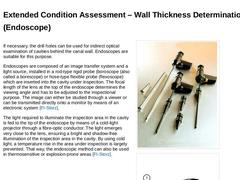
|
If necessary, the drill holes can be used for indirect optical examination of cavities behind the canal wall. Endoscopes are suitable for this purpose. Endoscopes are composed of an image transfer system and a light source, installed in a rod-type rigid probe (boroscope (also called a borescope) or hose-type flexible probe (flexoscope) which are inserted into the cavity under inspection. The focal length of the lens at the top of the endoscope determines … |
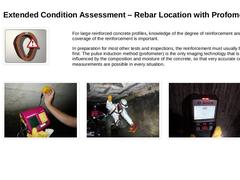
|
For large reinforced concrete profiles, knowledge of the degree of reinforcement and the coverage of the reinforcement is important. In preparation for most other tests and inspections, the reinforcement must usually be located first. The pulse induction method (profometer) is the only imaging technology that is not influenced by the composition and moisture of the concrete, so that very accurate concrete cover measurements … |
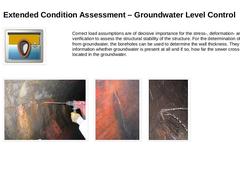
|
(Image: Icon Mauerwerk Grundwasser) Correct load assumptions are of decisive importance for the stress-, deformation- and stability verification to assess the structural stability of the structure. For the determination of the load from groundwater, the boreholes can be used to determine the wall thickness. They provide information whether groundwater is present at all and if so, how far the sewer cross-section is located in the groundwater. (Image: … |
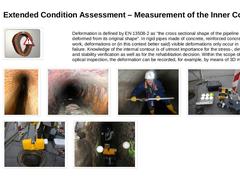
|
Deformation is defined by EN 13508-2 as “the cross sectional shape of the pipeline has been deformed from its original shape". In rigid pipes made of concrete, reinforced concrete or brick work, deformations or (in this context better said) visible deformations only occur in case of static failure. Knowledge of the internal contour is of utmost importance for the stress-, deformation and stability verification as well as for … |
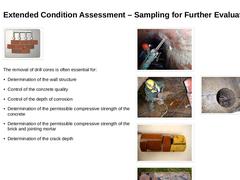
|
(Image: Icon Mauerwerk Last) The removal of drill cores is often essential for: -
Determination of the wall structure
-
Control of the concrete quality
-
Control of the depth of corrosion
-
Determination of the permissible compressive strength of the concrete
-
Determination of the permissible compressive strength of the brick and jointing mortar
-
Determination of the crack depth
(Image: Drill core sampling/extraction with drill core equipment in a walk-… |
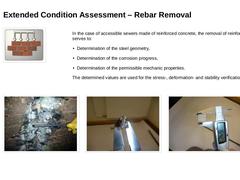
|
(Image: Icon Mauerwerk Last) In the case of accessible sewers made of reinforced concrete, the removal of reinforcing steel serves to: -
Determination of the steel geometry,
-
Determination of the corrosion progress,
-
Determination of the permissible mechanic properties.
The determined values are used for the stress-, deformation- and stability verification. (Image: Removal of reinforcing steel in a large profile) (Image: Removal of reinforcing steel … |
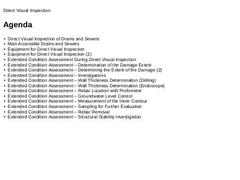
|
|
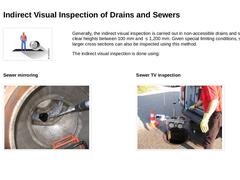
|
Generally, the indirect visual inspection is carried out in non-accessible drains and sewers with clear heights between 100 mm and ≤ 1,200 mm. Given special limiting conditions, smaller or larger cross sections can also be inspected using this method. The indirect visual inspection is done using: Sewer mirroring (Image: Indirect optical inspection of a sewerage system by means of a sewer mirror) Sewer TV inspection (Image: Indirect … |
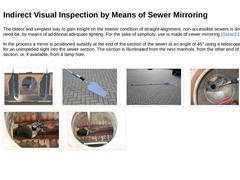
|
The oldest and simplest way to gain insight on the interior condition of straight-alignment, non-accessible sewers is direct viewing – if need be, by means of additional adequate lighting. For the sake of simplicity, use is made of sewer mirroring [Gürsc21]. In the process a mirror is positioned suitably at the end of the section of the sewer at an angle of 45° using a telescope bar to allow for an unimpeded sight into the sewer section. The section … |
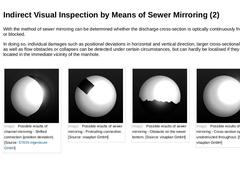
|
With the method of sewer mirroring can be determined whether the discharge cross-section is optically continuously free, restricted or blocked. In doing so, individual damages such as positional deviations in horizontal and vertical direction, larger cross-sectional deformations as well as flow obstacles or collapses can be detected under certain circumstances, but can hardly be localised if they are not located in the immediate vicinity of the manhole. |
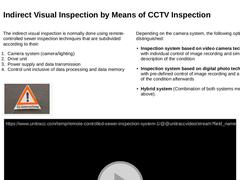
|
The indirect visual inspection is normally done using remote-controlled sewer inspection techniques that are subdivided according to their: -
Camera system (camera/lighting)
-
Drive unit
-
Power supply and data transmission
-
Control unit inclusive of data processing and data memory
(Image: Achtung TV-Untersuchung) Depending on the camera system, the following options are distinguished: |
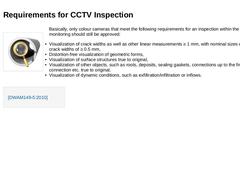
|
(Image: Picto Inspektion) Basically, only colour cameras that meet the following requirements for an inspection within the scope of self-monitoring should still be approved: -
Visualization of crack widths as well as other linear measurements ≥ 1 mm, with nominal sizes of ≤ DN 300 crack widths of ≥ 0.5 mm,
-
Distortion-free visualization of geometric forms,
-
Visualization of surface structures true to original,
-
Visualization of other objects, such as …
|
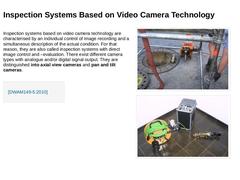
|
Inspection systems based on video camera technology are characterised by an individual control of image recording and a simultaneous description of the actual condition. For that reason, they are also called inspection systems with direct image control and –evaluation. There exist different camera types with analogue and/or digital signal output. They are distinguished into axial view cameras and pan and tilt cameras. |
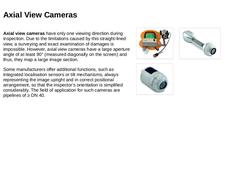
|
Axial view cameras have only one viewing direction during inspection. Due to the limitations caused by this straight-lined view, a surveying and exact examination of damages is impossible. However, axial view cameras have a large aperture angle of at least 90° (measured diagonally on the screen) and thus, they map a large image section. Some manufacturers offer additional functions, such as integrated localisation sensors or tilt mechanisms, always … |
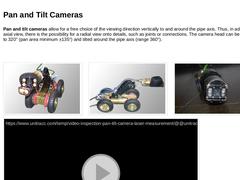
|
Pan and tilt cameras allow for a free choice of the viewing direction vertically to and around the pipe axis. Thus, in addition to the axial view, there is the possibility for a radial view onto details, such as joints or connections. The camera head can be panned by up to 320° (pan area minimum ±135°) and tilted around the pipe axis (range 360°). (Image: TV inspection system - Turn/swivel head camera of the company JT-elektronik GmbH with trolley - … |
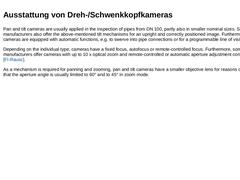
|
Pan and tilt cameras are usually applied in the inspection of pipes from DN 100, partly also in smaller nominal sizes. Some manufacturers also offer the above-mentioned tilt mechanisms for an upright and correctly positioned image. Furthermore, the cameras are equipped with automatic functions, e.g. to swerve into pipe connections or for a programmable line of vision [FI-IBAK]. Depending on the individual type, cameras have a fixed focus, autofocus … |
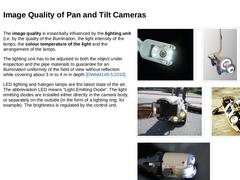
|
The image quality is essentially influenced by the lighting unit (i.e. by the quality of the illumination, the light intensity of the lamps, the colour temperature of the light and the arrangement of the lamps. The lighting unit has to be adjusted to both the object under inspection and the pipe materials to guarantee for an illumination uniformity of the field of view without reflection while covering about 3 m to 4 m in depth [DWAM149-5:2010]. LED … |
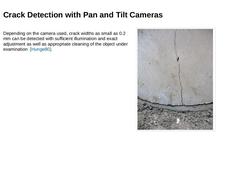
|
Depending on the camera used, crack widths as small as 0.2 mm can be detected with sufficient illumination and exact adjustment as well as appropriate cleaning of the object under examination [Hunge80]. (Image: Crack in a concrete pipe) |
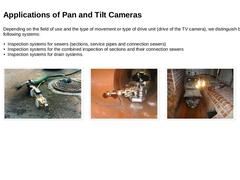
|
Depending on the field of use and the type of movement or type of drive unit (drive of the TV camera), we distinguish between the following systems: -
Inspection systems for sewers (sections, service pipes and connection sewers)
-
Inspection systems for the combined inspection of sections and their connection sewers
-
Inspection systems for drain systems.
(Image: TV inspection system for combined inspection of sewer pipes and their connecting sewers - … |
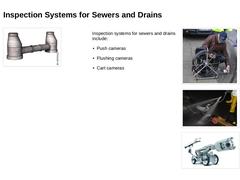
|
Inspection systems for sewers and drains include: -
Push cameras
-
Flushing cameras
-
Cart cameras
(Image: TV push camera of the company RITEC) (Image: Flushing Camera - TV Inspection Camera with Hydraulic Drive) (Image: Height adjustable trolley with side guide for oval pipes) |
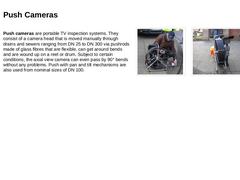
|
Push cameras are portable TV inspection systems. They consist of a camera head that is moved manually through drains and sewers ranging from DN 25 to DN 300 via pushrods made of glass fibres that are flexible, can get around bends and are wound up on a reel or drum. Subject to certain conditions, the axial view camera can even pass by 90° bends without any problems. Push with pan and tilt mechanisms are also used from nominal sizes of DN 100. |
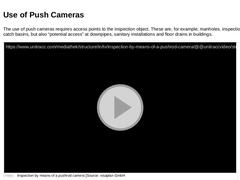
|
The use of push cameras requires access points to the inspection object. These are, for example, manholes, inspection chambers, catch basins, but also “potential access” at downpipes, sanitary installations and floor drains in buildings. (Video: Inspection by means of a pushrod camera) |
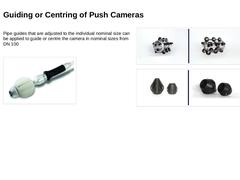
|
Pipe guides that are adjusted to the individual nominal size can be applied to guide or centre the camera in nominal sizes from DN 100 (Image: Push camera with accessories (pipe guide for DN 100)) (Image: Ritec roller slides from DN 150 (front and rear view)) (Image: RITEC push guides (left DN 160 and right DN 100)) |
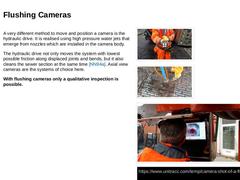
|
A very different method to move and position a camera is the hydraulic drive. It is realised using high pressure water jets that emerge from nozzles which are installed in the camera body. The hydraulic drive not only moves the system with lowest possible friction along displaced joints and bends, but it also cleans the sewer section at the same time [NN94a]. Axial view cameras are the systems of choice here. With flushing cameras only a qualitative … |
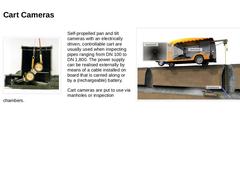
|
(Image: Insertion of the TV camera into a DN 150 pipe through an inspection opening with a diameter of 300 mm [FI-IBAK]) Self-propelled pan and tilt cameras with an electrically driven, controllable cart are usually used when inspecting pipes ranging from DN 100 to DN 1,800. The power supply can be realised externally by means of a cable installed on board that is carried along or by a (rechargeable) battery. Cart cameras are put to use via manholes … |